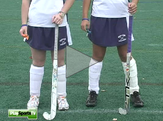PlaySportsTV Field Hockey
Field Hockey Tips: Playing on Natural Grass
.jpg)
The College of New Jersey field hockey coach Sharon Pfluger.
It can be a bumpy ride, so work on stick skills and make adjustments
By Craig Haley
PlaySportsTV Managing Editor
The College of New Jersey field hockey coach Sharon Pfluger says all natural grass fields in her sport should be well-maintained. Then she laughs because she knows it’s not true.
Her national championship program has played home games on Astroturf, and now synthetic turf, for many years, which helps the Lions play a faster, more-skilled style. But they also play road games on natural grass, so Pfluger prepares her players accordingly. She calls the bumps and divots on a natural grass an unknown factor and believes girls' field hockey coaches should explain the effects of a poorly maintained field to their players and teach them how to make necessary adjustments with their field hockey sticks.
Playing field hockey on a natural grass field can be especially troublesome because the ball is small and harder to control than, say, a soccer ball. It's susceptible to an odd bounce. Thus, players should practice stickhandling, dribbling and passing drills on grass fields to get a feel for moving their stick around and handling any lift with the ball. You wind up pushing the ball harder on a grass field.
“You’re forced to (play at a slower pace) because there’s more friction in the grass itself,” says Pfluger, who has coached TCNJ to seven NCAA Division III national championships. “There’s divots on the field and all the problems.”
“The (artificial) turf is flat, so you know and you can pre-think a move. On grass, you can think it through, but the chances of the ball not going where you want it to go – not even putting an opponent in the picture – is higher.”
An artificial turf field offers allows the field hockey ball to have a truer roll. The point of impact will determine the ball’s direction, while the imperfections with a natural grass field can change the ball’s direction. Youth players can get discouraged by these occurrences.
“Because you can’t always execute properly on a real bumpy field, it’s really hard for the players to think that they’re doing it properly,” Pfluger says. “So one thing we have to teach them is how to adjust to the grass. How do you angle the stick? Where should the blade of the stick go in order to adjust to the surface?
“Turf is most definitely the preferred surface.”
###
Photo courtesy of The College of New Jersey



